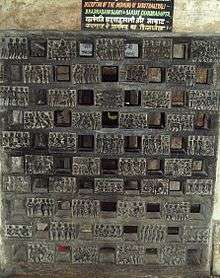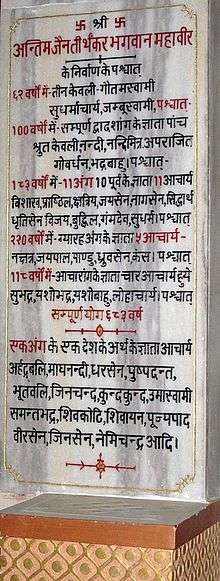Bhadrabahu
| Shruta-kevalin Acharya Shri Bhadrabahu Ji Maharaj | |
|---|---|
 Inscription of the incoming of Shrutakevali Bhadrabahu swami and Chandragupta Maurya (Shravanabelagola) | |
| Religion | Jainism |
| Sect | Digambara |
| Personal | |
| Born | c. 433 BCE |
| Died |
c. 357 BCE Shravanbelgola |
| Parents |
|
| Senior posting | |
| Successor | Acharya Vishakha |
| Religious career | |
| Ascetics initiated | Chandragupta Maurya |
| Works | Uvasagharam Stotra |
| Initiation | by Govarddhana Mahamuni (Shruta Kevalin) |
| Part of a series on |
| Jainism |
|---|
 |
|
Jain prayers |
|
Ethics |
|
Major figures |
|
Major sects |
|
Festivals |
|
Pilgrimages |
|
|
Bhadrabahu (c. 433 – c. 357 BCE) was the last Shrut Kevali (all knowing by hearsay, that is indirectly) in Jainism. He was a Digambara Acharya and the spiritual teacher of Chandragupta Maurya.[1]
There were five Shruta Kevalis in Jainism - Govarddhana Mahamuni, Vishnu, Nandimitra, Aparajita and Bhadrabahu.[2]
Early life
Bhadrabahu was born in Pundravardhana (now in Bangladesh) to a Brahmin family[3] during which time the secondary capital of the Mauryas was Ujjain. When he was seven, Govarddhana Mahamuni predicted that he will be the last Shruta Kevali and took him along for his initial education.[2] He was then initiated as a Digambara Muni and by practicing gyan, dhyan, tap and sanyam got the Acharya pad.[4]
According to Śvētāmbara tradition, he lived from 433 BC to 357 BC.[5] Digambara tradition dates him to have died in 365 BC.[6]
Ascetic life
On the night of full moon in the month of Kartik, Chandragupta Maurya (founder and ruler of Maurya Empire) saw sixteen dreams, which were then explained to him by Acharya Bhadrabahu.[4]
| S. No. | Dream of Chandragupta | Explanation by Bhadrabahu |
|---|---|---|
| 1 | The sun setting | All the knowledge will be darkened |
| 2 | A branch of the Kalpavriksha break off and fall | Decline of Jainism and Chandragupta's successors won't be initiated |
| 3 | A divine car descending in the sky and returning | The heavenly beings will not visit Bharata Kshetra |
| 4 | The disk of the moon sundered | Jainism will be split into two sects |
| 5 | Black elephants fighting | Lesser rains and poorer crops |
| 6 | Fireflies shining in the twilight | True knowledge will be lost, few sparks will glimmer with feeble light |
| 7 | A dried up lake | Aryakhanda will be destitute of Jain doctrines and falsehood increase |
| 8 | Smoke filling all the air | Evil prevail and goodness hidden |
| 9 | An ape sitting on a throne | Vile, low-born, wicked will acquire power |
| 10 | A dog eating the payasa out of a golden bowl | Kings, not content with a sixth share, will introduce land-rent and oppress their subjects by increasing it |
| 11 | Young bulls labouring | Young will form religious purposes, but forsake them when old |
| 12 | Kshatriya boys riding donkeys | Kings of high descent will associate with the base |
| 13 | Monkeys scaring away swans | The low will torment the noble and try to reduce them to same level |
| 14 | Calves jumping over the sea | King will assist in oppressing the people by levying unlawful taxes |
| 15 | Foxes pursuing old oxen | The low, with hollow compliments, will get rid of the noble, the good and the wise |
| 16 | A twelve-headed serpent approaching | twelve year of death and famine will come upon this land[7] |

Bhadrabahu decided the famine would make it harder for monks to survive and migrated with a group of twelve thousand disciples to South India,[8][9] bringing with him Chandragupta, turned Digambara monk.[10][7]
According to the inscriptions at Shravanabelgola, Bhadrabahu died after taking the vow of Sallekhana.[11]
Works
According to Svetambaras, Bhadrabahu was the author of Kalpa Sūtra,[12] four Chedda sutras, commentaries on ten scriptures, Bhadrabahu Samhita and Vasudevcharita.[13][3]
Legacy
Bhadrabahu, who was a Digambara Acharya, remains an exemplar of dedication to first principles at any cost. After him, the Sangha split into two separate teacher-student lineages of monks. Digambara monks belong to the lineage of Acharya Vishakha and Svetambara monks follow the tradition of Sthulabhadra.
Regarding the inscriptions describing the relation of Bhadrabahu and Chandragupta Maurya, Radha Kumud Mookerji writes
The oldest inscription of about 600 AD associated "the pair (yugma), Bhadrabahu along with Chandragupta Muni." Two inscriptions of about 900 AD on the Kaveri near Seringapatam describe the summit of a hill called Chandragiri as marked by the footprints of Bhadrabahu and Chandragupta munipati. A Shravanabelagola inscription of 1129 mentions Bhadrabahu "Shrutakevali", and Chandragupta who acquired such merit that he was worshipped by the forest deities. Another inscription of 1163 similarly couples and describes them. A third inscription of the year 1432 speaks of Yatindra Bhadrabahu, and his disciple Chandragupta, the fame of whose penance spread into other words.[10]
Bhadrabahu-charitra was written by Ratnanandi of about 1450 AD.[10]
See also
| Wikimedia Commons has media related to Bhadrabahu. |
Notes
- ↑ Wiley 2009, p. 51.
- 1 2 Rice 1889, p. 3.
- 1 2 Jaini, Padmanabh (2000). Collected Papers on Jaina Studies. Motilal Banarasidass. p. 299.
- 1 2 Rice 1889, p. 4.
- ↑ Vidyabhusana 2006, p. 164.
- ↑ Vidyabhusana 2006, p. 164-165.
- 1 2 Sangave 2001, p. 174.
- ↑ Dundas 2002, p. 47.
- ↑ Rice 1889, p. 5.
- 1 2 3 Mookerji 1988, p. 40.
- ↑ Sangave 1981, p. 32.
- ↑ Mookerji 1988, p. 4.
- ↑ Wiley 2009, p. 52.
References
- Wiley, Kristi L (16 July 2009), The a to Z of Jainism, p. 51, ISBN 9780810868212
- Sangave, Vilas Adinath (2001), Facets of Jainology: Selected Research Papers on Jain Society, Religion, and Culture, Popular Prakashan, ISBN 978-81-7154-839-2
- Dundas, Paul (2002) [1992], The Jains (Second ed.), Routledge, ISBN 0-415-26605-X
- Sangave, Vilas Adinath (1981), The Sacred Sravana-Belagola: A Socio-religious study (First ed.), Bharatiya Jnanpith
- Pereira, José (1977), Monolithic Jinas, Motilal Banarsidass, ISBN 0-8426-1027-8
- Mookerji, Radha Kumud (1988) [first published in 1966], Chandragupta Maurya and his times (4th ed.), Motilal Banarsidass, ISBN 81-208-0433-3
- Vidyabhusana, Satis Chandra (2006) [1920], A History of Indian Logic: Ancient, Mediaeval and Modern Schools, Motilal Banarsidass, ISBN 81-208-0565-8